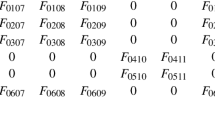Abstract
Methods of quasi-static deformation and fracture analysis are developed for a class of nonlinear viscoelastic media and sample applications are given. Selection of the class of media is guided by actual rheological behavior of monolithic and composite materials as well as the need for simplicity to be able to understand the effect of primary material and continuum parameters on crack growth behavior. First, pertinent aspects of J integral and energy release rate theory for nonlinear elastic media are discussed. Nonlinear viscoelastic constitutive equations are then given, and correspondence principles which establish a simple relationship between mechanical states of elastic and viscoelastic media are developed. These principles provide the basis for the subsequent extension of J integral theory to crack growth in viscoelastic materials. Emphasis is on predicting mechanical work available at the crack tip for initiation and continuation of growth; some examples show how viscoelastic properties and the J integral affect growth behavior. Included is the problem of a crack in a thin layer having different viscoelastic properties than the surrounding continuum. The Appendix gives an apparently new constitutive theory for elastic and viscoelastic materials with changing microstructure (e.g. distributed damage) and indicates the conditions under which the fracture theory in the body of the paper is applicable.
Résumé
On développe des méthodes d'analyse des déformations et de rupture quasi statiques pour une classe de mileux visco-élastiques non linéaires et on illustre des applications types de ces méthodes. Le choix de la classe est dicté par le comportement rhéologique réel de matériaux monolitiques ou composites, ainsi que par la nécessité de simplifier l'approche pour comprendre l'effet des paramètres de base du matériau et du continuum sur leur comportement vis-à-vis de la croissance de la fissure. On discute en premier lieu la pertinence des théories de l'intégraleJ et du taux de relaxation d'énergie, dans le cas de milieux élastiques non linéaires. On établit ensuite des équations visco-élastiques non linéaires et on développe les principes de correspondance qui permettent de mettre en place une relation simple entre les état mécaniques correspondant à des milieux élastiques et à des milieux visco-élastiques. On tire des principes une base pour étendre la théorie de l'intégraleJ à la croissance de fissures dans les matériaux visco-élastiques. L'accent est placé sur la prédiction du travail mécanique susceptible d'amorcer et d'entretenir la croissance d'une fissure à l'extrémité de celle-ci. Quelques exemples montrent comment le comportement à la croissance est influencé par les propriétś visco-élastiques et par l'intégraleJ. L'étude couvre le cas d'une fissure dans une couche mince présentant des propriétés visco-élastiques distinctes de celles du substrat. En annexe, on présente une théorie apparemment originale sur les matériaux élastiques et visco-élastiques comportant des microstructures évolutives et on indique les conditions selon lesquelles la théorie de la rupture discutée dans le mémoire est applicable.
Similar content being viewed by others
References
D. Broek,Elementary Engineering Fracture Mechanics, Third revised edn., Martinus Nijhoff Publishers (1982).
G.J. Lake, inProgress of Rubber Technology, Applied Science Publishers Ltd. (1983) 89–143.
J.R. Rice,Journal of Applied Mechanics 35 (1968) 379–386.
J.D. Landes and J.A. Begley, inMechanics of Crack Growth, ASTM STP 590, American Society for Testing and Materials (1976) 128–148.
R.A. Schapery,International Journal of Fracture 11 (1975): Part 1, 141–159; Part 11, 369–388; Part 111, 549–562.
A.A. Kaminskii,Prikladnaya Mekhanika 16 (1980) (English translation (1981) Plenum) 3–26.
R.M. Christensen,Theory of Viscoelasticity, An Introduction, Second edn., Academic Press (1982).
G.S. Brockway and R.A. Schapery,Engineering Fracture Mechanics 10 (1978) 453–468.
R.A. Schapery,International Journal of Fracture 14 (1978) 293–309.
F.H.K. Chen and R.T. Shield,Journal of Applied Mathematics and Physics ZAMP, 28 (1977) 1–22.
R.T. Shield, inFinite Elasticity, R.S. Rivlin Ed., The American Society of Mechanical Engineers (1977) 1–10.
R.A. Schapery, inEncyclopedia of Materials Science and Engineering, Pergamon Press LTD (1984). (To appear).
E. Passaglia,Polymer 23 (1982) 754–760.
R.A. Schapery, in 1981Advances in Aerospace Structures and Materials, S.S. Wang and W.J. Renton, Eds., The American Society of Mechanical Engineers (1981) 5–20.
R.A. Schapery, inProceedings Ninth U.S. National Congress of Applied Mechanics, The American Society of Mechanical Engineers (1982) 237–245.
J.K. Knowles and E. Sternberg,Archive for Rational Mechanics and Analysis 44 (1972) 187–211.
Y.C. Fung,Foundations of Solid Mechanics, Prentice-Hall, Inc. (1965).
M.D. Greenberg,Foundations of Applied Mathematics, Prentice-Hall, Inc. (1978).
W.N. Findley,Journal of Applied Mechanics 48 (1981) 47–54.
W.G. Knauss, inDeformation and Fracture of High Polymers, H. Henning Kausch, John A. Hassell and Robert I. Jaffee, (eds.), Plenum Press (1974) 501–541.
L.N. McCartney,International Journal of Fracture 15 (1979) 31–40.
N.W. Tschoegl,Polymer 20 (1979) 1365–1370.
W.L. Bradley and R.N. Cohen, inProceedings Fourth International Conference on Mechanical Behavior of Materials, J. Carlsson and N.G. Ohlson, Pergamon Press (1983) 595–604.
R.W. Hertzberg and J.A. Manson, inFatigue of Engineering Plastics, Academic Press (1980) 160.
A.J. Kinloch,Metal Science (1980) 305–318.
L.E. Malvern,Introduction to the Mechanics of a Continuous Medium, Prentice-hall, Inc. (1969).
J.G. Williams,Fracture Mechanics of Polymers, Halstead Press, John Wiley & Sons (1984).
Author information
Authors and Affiliations
Rights and permissions
About this article
Cite this article
Schapery, R.A. Correspondence principles and a generalizedJ integral for large deformation and fracture analysis of viscoelastic media. Int J Fract 25, 195–223 (1984). https://doi.org/10.1007/BF01140837
Received:
Revised:
Issue Date:
DOI: https://doi.org/10.1007/BF01140837




